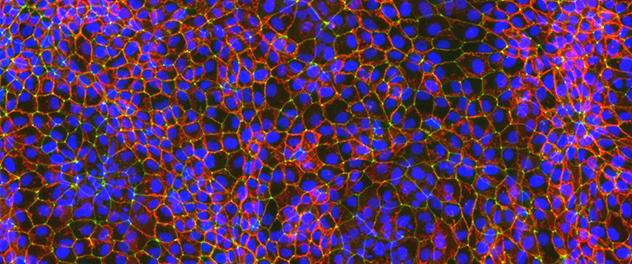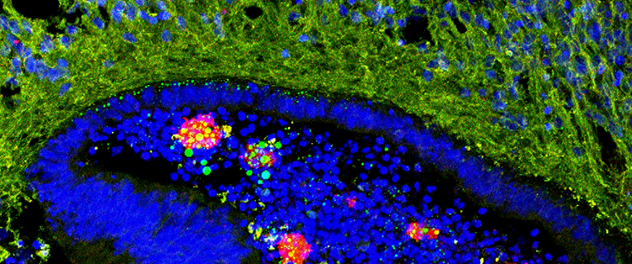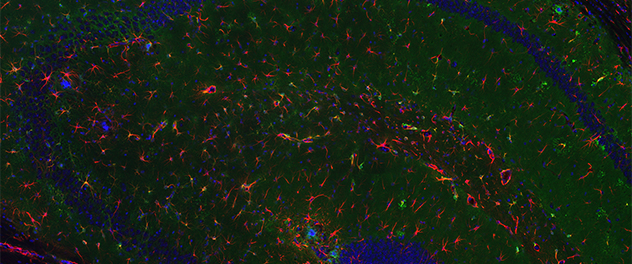-

Human induced pluripotent stem cells differentiated into endothelial cells
Pictured are human induced pluripotent stem cells differentiated into endothelial cells. These cells are expressing tight junction protein ZO-1, shown in green, and glucose transporter GLUT1. Both of these proteins are characteristically expressed along the cell membranes of endothelial cells in the brain. Their nuclei are shown in blue. These cells are used to understand the impact of apolipoprotein E isoforms on the neurovascular interface in the brain.
-

Section of a cerebral organoid with microglialike cells
Pictured is a section of a cerebral organoid with microglialike cells that are generated from human induced pluripotent stem cells. The microglialike cells express IBA1, shown in red, and the neurons express β tubulin III, shown in green. The cells of all nuclei are shown in blue. This organoid with these immune cells is used to study the impact of ABCA7 deficiency in Alzheimer's disease.
-

Section of hippocampus from a transgenic mouse model
The lab uses transgenic mouse models to study the impact of apolipoprotein E isoforms on the brain. In this image of a thin slice of hippocampus from a mouse, the nuclei of the cells are shown in blue. Hyaluronic acid, the primary extracellular matrix component of the brain, is shown in green. The astrocytes expressing glial fibrillary acidic protein are shown in red.
Overview
The Lipid Homeostasis and Neurobiology in Aging and Dementias Laboratory, which is led by Takahisa Kanekiyo, M.D., Ph.D., is part of the Department of Neuroscience on Mayo Clinic's Florida campus. The lab studies the pathogenic pathways of aging and age-related neurodegenerative diseases. Investigations in the lab span the breadth of different cell types in the brain and probe the depths of lipid homeostasis.
By dry weight, lipids make up half of the human brain. Lipids are a class of fatty organic compounds. They are one of the four classes of macromolecules found in living things.
Examples of lipids within the human body include:
- Fats.
- Fat-soluble vitamins, such as vitamins A and K.
- Hormones.
- Sterols, such as cholesterol.
- Phospholipids, the primary component of cell membranes.
Lipids serve various roles in the human body. For these reasons, proper trafficking and processing of lipids in the body, especially in the brain, are critical to human health and homeostasis.
Alzheimer's disease, one of many different age-related dementias, is believed to have a diverse set of causes and corresponding risk factors. The greatest risk factor is age.
Genetic risk factors play a role in early-onset and late-onset forms of Alzheimer's disease. Apolipoprotein E (APOE) is the greatest genetic risk factor for the late-onset form of this disease. ATP-binding cassette transporter A7 (ABCA7) is another strong genetic risk factor for late-onset Alzheimer's disease. Given that both APOE and ABCA7 are involved in lipid homeostasis, Dr. Kanekiyo and his team investigate the intricate relationship between lipid homeostasis and neurobiology within the scope of aging and neurodegeneration.
The Lipid Homeostasis and Neurobiology in Aging and Dementias Lab uses many research tools and models to reach these goals:
- Further understand the mechanisms of healthy and pathological aging in the brain.
- Characterize lipid homeostasis and metabolism across nearly every cell type in the brain.
- Develop effective therapies for dementias such as Alzheimer's disease.
Beyond research, Dr. Kanekiyo and his team also seek to inspire scientific curiosity from all people through rigorous yet compassionate mentorship. They also seek to advance science through numerous synergistic collaborations within and beyond Mayo Clinic.